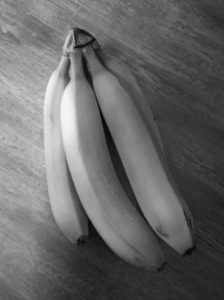True. 
Our family eats a lot of fruit. It would be nearly impossible to walk through our kitchen or look into our fridge and not see apples, bananas, peaches, pears, blueberries or grapes.
We prefer fresh fruits whenever possible. For example, every spring we make multiple visits to a pick-your-own strawberry farm just a few miles from our home. We hop on a hay trailer pulled by a tractor that leads us through the woods to a number of huge, hidden fields filled with strawberry patches.
What a joy it is to pick strawberries fresh off the plant and to see our kids get excited about eating something so healthy for them! As evidence of our visit and their indulgence, the red strawberry-juice stain around their mouths lasts nearly the entire day.
We live in the Midwest, and I’m writing this the morning after a moderate winter storm left us with just over six inches of beautiful, fluffy white snow. I know there are no strawberries under that snow, so when I eat fruit in the winter, I always check the container to see where it was grown. For strawberries, it is always California—always!
Seeing the origin prompts me to think: How can they pick fruit in a state like California and ship it to the Midwest without having it spoil or get overripe?
Fruit goes through a gradual ripening process. I’m sure most of us have taken a bite of a banana that’s not quite ripe and found an unpleasant, bitter taste. As fruit ripens, it becomes softer, more colorful and sweeter, which is why the yellow banana tastes better than the green one—for most of us, anyway.
But ripe fruits don’t ship well because they are softer and more likely to bruise and spoil or get damaged over the miles. at’s why so many fruits are picked before they ripen, including the strawberries my family eats during the winter. Agents such as ethylene gas are used to speed the ripening process of fruits at their destination. Ethylene is a hormone naturally found in plants and is generally recognized as safe by the Food and Drug Administration. Most fruits produce small amounts of ethylene on their own, so ripening fruit with ethylene simply speeds the normal ripening process. There are no chemical or physiological differences in fruit allowed to ripen on the vine versus those ripened with introduced ethylene.
Cutting, scraping or damaging fruit will increase ethylene production, and shortening the ripening time this way has its roots in biblical times. In the article “One rotten apple spoils the whole bushel: The role of Ethylene in fruit ripening” (1992), Athanasios Theologis writes, “ The earliest record of human manipulation causing fruit to ripen is in the Old Testament: the prophet Amos described himself as a ‘piercer’ of sycamore fig fruit. The Greek philosopher Theophrastus later recognized that sycamore figs do not ripen unless they are scraped with an iron claw.”
In fact, that is where the saying “One rotten apple spoils the whole bushel” comes from. It is possible for one damaged apple to start releasing increased amounts of ethylene and spoil apples stored with it. The snow and cold weather will be gone soon enough, and we’ll be able to take another trip to the strawberry patch where we can pick and eat strawberries until we’re ready to burst. Until then, I will settle for eating strawberries picked in California and ripened with ethylene.
Theologis, A: One rotten apple spoils the whole bushel: The role of Ethylene in fruit ripening. Cell (1992), Vol 70, pp. 181-184.
